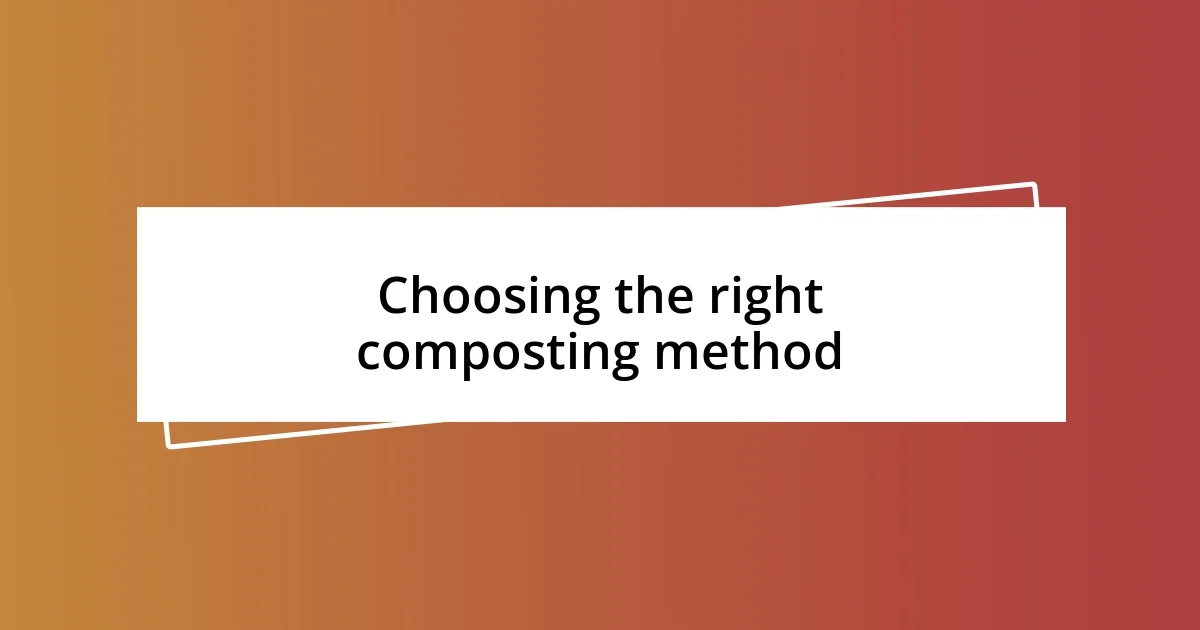Key takeaways:
- Composting significantly improves soil health and reduces kitchen waste, promoting sustainability while saving money on fertilizers.
- Choosing the right composting method (cold, hot, or vermicomposting) is essential and should align with your space, time, and waste type.
- Effective composting requires balancing greens and browns, regular maintenance, and observing for issues like moisture levels and pests to ensure a thriving compost ecosystem.

Understanding composting benefits
One of the most rewarding benefits I discovered while composting is how it naturally enhances soil health. The first time I used my homemade compost in my garden, I could almost feel the soil come alive. I know it sounds a bit poetic, but there was a noticeable difference in the plant growth; they thrived in a way that made my heart swell with pride!
Another advantage is the significant reduction in waste that composting creates. Have you ever thought about how much of our kitchen scraps end up in the landfill? I was shocked when I calculated that my household could divert nearly half of its waste through composting. It’s like taking a small yet powerful step towards sustainability, and I can’t help but feel empowered knowing I’m doing something positive for the environment.
Additionally, composting can save you money in the long run. When I started using my compost instead of store-bought fertilizers, I was pleasantly surprised by how much I saved over the years. Have you ever realized that small changes can lead to significant savings? It’s not just about the environment; it’s about nurturing my garden and my wallet at the same time.

Choosing the right composting method
Choosing the right composting method can be a pivotal decision in your composting journey. Personally, I felt a mix of excitement and confusion at first, overwhelmed by the options available. I remember standing in my backyard, wondering whether a simple bin or a more advanced system would meet my needs best. It really comes down to assessing your space, time, and the type of waste you plan to compost.
The three most common methods are cold composting, hot composting, and vermicomposting. Each method has its benefits and considerations. For instance, cold composting is great for a hands-off approach, but it takes a while to break down. On the flip side, hot composting offers faster results but demands more effort and knowledge. It was fascinating for me to see how my own lifestyle and gardening goals influenced which method I ultimately chose.
When I switched to vermicomposting, I was pleasantly surprised by how much I enjoyed the process. Watching the worms work their magic was like witnessing nature’s tiny artisans at work. Have you ever had that moment of joy when you see a new life flourishing in your garden? It confirmed for me that the right method truly enhances not just the soil, but the gardener’s journey as well.
| Composting Method | Pros | Cons |
|---|---|---|
| Cold Composting | Low maintenance, requires little space | Longer decomposition time |
| Hot Composting | Faster results, excellent heat generation | Requires balancing materials and regular monitoring |
| Vermicomposting | Odor-free, great for small spaces | Setup can be more intricate, requires specific worms |

Selecting materials for composting
When I first began selecting materials for my composting system, I quickly learned that the balance between greens and browns is crucial. It felt a bit like cooking; too much of one ingredient can throw the whole dish off. Greens, which include kitchen scraps like vegetable peels and coffee grounds, are rich in nitrogen. On the other hand, browns like dried leaves and cardboard provide carbon. Achieving that right ratio not only speeds up the composting process but also enhances the quality of the compost.
Here’s a quick list of materials I found particularly effective:
-
Greens (Nitrogen-rich)
- Fruit and vegetable scraps
- Coffee grounds
- Grass clippings
- Manure (from herbivores)
-
Browns (Carbon-rich)
- Dry leaves
- Straw or hay
- Shredded cardboard
- Paper towels (uncoated)
As I dove into this process, I felt a sense of connection to the Earth. Selecting materials wasn’t just an act of composting; it was a conscious choice to recycle and nurture the environment. Standing over my compost pile, I sometimes felt like a modern alchemist, turning what others deemed waste into gold for my garden. Each weekend I would delight in exploring my kitchen and yard, collecting items that would transform into rich, dark compost. It was fascinating to consider how even humble scraps could contribute to nurturing life. That realization really deepened my appreciation for the entire composting journey.

Setting up your composting system
Setting up your composting system starts with the right location. I remember my own experience of wandering around my yard, looking for a sunny spot with good drainage—a space that felt just right. It’s important to find a balance; too much shade can slow down the decomposition process, while a spot that’s too wet can lead to unpleasant odors. Have you thought about where you’d put your compost pile or bin? Taking the time to choose wisely can make or break your composting success.
Once the location is sorted, I found that having the right tools on hand made everything smoother. A trusty pitchfork for aerating the pile and a bucket for gathering scraps became my composting companions. The first time I tossed kitchen scraps into my bin and mixed them up, I felt like I was adding the final touches to a work of art. You really don’t need a lot of fancy equipment—just what feels comfortable and practical for you.
Finally, layering is a technique that transformed my composting game. I learned to alternate between layers of greens and browns, almost like making a lasagna. The first few weeks, I found it playful to build my compost, fostering a sense of anticipation as I imagined the rich, nutrient-dense soil that would eventually emerge. Have you ever stopped to appreciate how these seemingly ordinary items could lead to such marvelous transformations? That anticipation is what kept me engaged and motivated throughout the process.

Maintaining your compost pile
Maintaining your compost pile is where the real magic happens. I remember a time early on when I neglected my pile for a few weeks, thinking it would take care of itself. Upon returning, I was greeted with a rather unpleasant odor—definitely not what I envisioned! Since then, I’ve made it a habit to turn the pile regularly, ideally every couple of weeks. Not only does this aerate the compost, but it also brings together those nitrogen-rich greens and carbon-heavy browns to create a more uniform blend.
Moisture levels are another crucial aspect I’ve learned to monitor closely. Just like I wouldn’t want a dish to be too dry or too soggy, every compost pile needs a balanced level of moisture. After a heavy rain, I’ve sometimes found my pile overly wet, which can create anaerobic conditions that lead to a smelly disaster. A simple fix, I’ve discovered, is adding dry straw or shredded leaves to soak up excess moisture. It’s a surprisingly satisfying feeling to rescue the pile and watch it thrive once again.
Lastly, I can’t stress enough how observing the worms and critters busily working away can be incredibly rewarding. Seeing the vibrant ecosystem developing right in my backyard brought me immense joy. They’re nature’s little recyclers, after all! Have you taken the time to appreciate what’s happening in your pile? Watching this transformation reminds me that composting isn’t just about the end product; it’s about nurturing a community of life.

Troubleshooting composting issues
Even after getting the hang of composting, I still faced a few hiccups along the way. One afternoon, I caught a whiff of something foul and discovered my compost bin was too wet. I remember feeling disheartened at first, thinking I had ruined my hard work. But I quickly learned that adding dry materials—like cardboard or egg cartons—could help balance everything out. Have you ever had that lightbulb moment when you realize a simple fix can turn around a discouraging situation?
Another issue I’ve grappled with is pests. I vividly recall a time when I opened my bin and found a parade of fruit flies buzzing around my kitchen scraps. It was enough to make me question my composting efforts. After some research, I discovered that burying the scraps deeper in the pile can help deter these unwelcome guests. It’s funny how these pesky moments turn into valuable lessons—have you ever noticed how trial and error can lead to unexpected solutions?
Temperature fluctuations can also signal a problem, and I learned this the hard way during a chilly winter. One day, I felt a bit discouraged as I noticed my compost pile was hardly warming up. I had to remind myself that patience plays a key role in composting. When I added some fresh greens, it was like a spark for the pile, and it soon burst back to life. Have you experienced that delightful feeling of reviving something that seemed lost? It’s a reminder that even in composting, just like life, resilience is crucial.

Harvesting and using compost effectively
After the waiting period, harvesting compost is like unearthing buried treasure! I still remember that day when I finally sifted through my first batch. The dark, crumbly material had such a rich, earthy smell that was incredibly satisfying. If you’re like me, you might wonder how to know when your compost is ready. I’ve found that when the original materials are unrecognizable and the compost feels cool, it’s time to take the plunge and start using it.
Using compost effectively is a game changer for gardens. I absolutely love mixing it into the soil before planting. The first year I did this, my tomato plants were stronger and produced more fruit than ever before! It’s fascinating to see how a healthy compost can enhance soil structure, encourage earthworms, and promote steady moisture retention—almost like giving your plants a nutrient-packed hug. Have you noticed your plants thriving more when they have that little extra love?
Top dressing your plants with compost is another technique I’ve grown fond of. I sprinkle a layer on the surface as a gentle reminder of the nutrient boost beneath the soil. This practice not only feeds the plants slowly over time but also helps suppress weeds. The sense of accomplishment I feel every time I see my garden flourishing is simply unmatched! It’s rewarding to know that I’m nurturing both my plants and my composting efforts, isn’t it?














